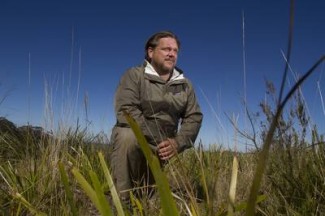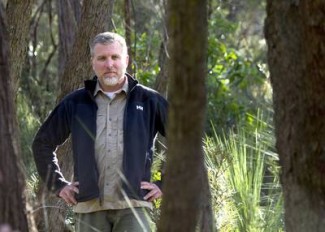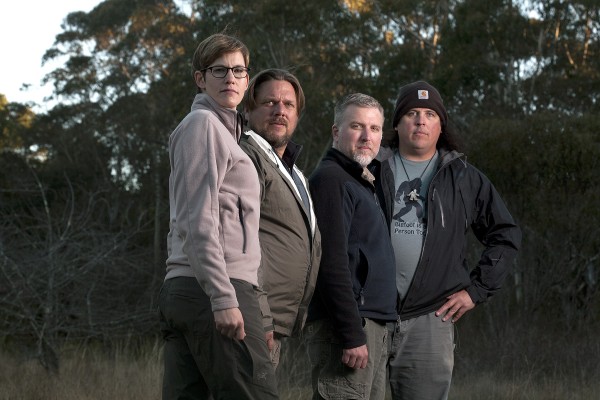‘Finding Bigfoot’ guys offer their latest evidence and describe America’s best Sasquatch area

Finding Bigfoot, the hit Animal Planet show that recently returned for its second season, tracks a quartet of Sasquatch investigators on their mission to find evidence of the Big Man. Matt Moneymaker and Cliff Barackman have several theories about the evasive “Missing Link,” and recently they shared their thoughts with Hollywood Soapbox.
In the below interview, the guys talk about “ground zero” in North America on where to find a Bigfoot and what adventures will be presented in the second season. Questions and answers have been slightly edited.
You had such success with the first season, what can audience members expect in season two?
Cliff: Well, the season … is going to be packed with new places where we went overseas for the first time to try our North American techniques on critters that live across the ocean. We have new search techniques. We teamed up with FLIR Thermal Imaging, for example, and used their technology in our search. And really their technology, the stuff that they brought out to the field, has never been deployed looking for Sasquatch. …
So we went to new places, new search techniques, and it’s a whole lot of fun. It was an amazing season.
How does this season compare to the first as far as the evidence you found? Is it pretty amazing?
Matt: We’re getting better. Throughout both season one and season two, we’ve gotten close enough to them to hear them. And those kind of recordings are evident, especially when you hear them. You can tell, if you are familiar with animal sounds, you know that those aren’t any other kind of animal. So we got better at recording them.
I think because the name of the show is Finding Bigfoot, people are very concerned about what we find, as in objects or tracks, etc., like that. But with Sasquatches, they don’t leave much findable things behind. So you’re not going to really find things that you can pick up and take away with you.
What you will find along the way is you’ll find witnesses who had very important observations. They’ll tell you about behavior, even though they’re just telling you about what they saw. But then they’ll tell you where it happened and in those areas you have a chance to learn a little bit more about them, learn about their habitat and have a chance of getting them to potentially approach you.
So, I guess, one thing you could say we found, especially overseas, going to some place like Australia, talking to a lot of the witnesses, going out into those environments, what we found is that they’ve got a similar phenomena going on over there. And it’s almost counter-intuitive, at least you would think, because in Australia the mammals there are supposed to be all marsupials. And when we go there, we found that, no, actually most of the mammals are marsupials, but there are placental mammals as well. … Which means some mammals were able to get across from New Guinea, probably during the Ice Age when the water levels were lower, and we think that the same things — big, tall, dark-furred, giant, ape-like things, like people see in the U.S. — made it across there.
Because people are describing seeing the same things. They’re finding the same type of tracks when they were there. I wasn’t out with them that night, but they actually heard Sasquatches making sounds very similar to the sounds that they make here, the kind of gruff growling, roar sounds, and then pushing trees over and snapping branches, in a very intimidating way. So that was important, and also going to places where you wouldn’t have expected that some would be, like in South Dakota in sort of the grasslands there. … I had been there before, so I knew there were good witnesses. But being on an Indian reservation there, and finding out that, yeah, there’s places even there where there’s ton of deer and there’s lots of habitat, and animals like this are apparently there as well, judging by the amount of people who have seen them.

Do you ever get to an eyewitness that you think is genuine but mistaken?
Matt: The misinterpretation is usually not during visual situations. The misinterpretation is usually when they’re just hearing sounds or they’re just finding what they think may be tracks. Tracks are very often misinterpreted. … It depends on the circumstances. If you had a witness on a stand, and you’re talking about a witness to a car accident, one of the things a lawyer will do is find out how well they could have observed it. Was there bushes in between? Was the lighting right? …
The witnesses you see in the show, the ones that we’ll go check out the reports, tend to be the ones that have pretty clear visual sightings, such that it boils down to whether it’s either they’re lying about it, or they saw somebody in a Bigfoot costume or they saw a Bigfoot.
What was the experience when you came to the realization that there were Sasquatches out there?
Cliff: I’ve been interested in monsters or whatever basically all my life. I think every little boy loves monsters of some sort, and I guess some of us just don’t grow up. But it wasn’t until I was in college actually that I came to the realization like, holy smoke, these things might actually be there, instead of just being some sort of cultural phenomena of quirkiness.
I was going through the library at my college on a break between school and I ran across a collection of scholarly papers published in a journal on Sasquatches. And a lot of these papers were written from the perspective of cultural anthropologists, saying that, oh yeah, pretty much every Native American tribe has Sasquatches as part of their oral history and mythology. But some of those papers were also written by physical anthropologists, noting how the inferred mythology, the underlying anatomy of the foot skeleton in those footprints, is exactly what would be necessary to carry a biped of that size and weight.
And I really started coming to the conclusion like, holy smokes, these scientists are saying that there’s probably something here. … And even if one of those people is right, then the species is real. And it was just kind of an awakening to the amount of information and data out there that supports the hypothesis that Sasquatches are, in fact, real animals.
Matt: I had realized they must be there even when I was 10 years old and saw those documentaries. And I met witnesses, and it was beyond just being real. But they were in a mountain range not far away from me. So they were accessible. That made them even more real. About six months after that, I actually went up and found tracks. And at that point, they’re not just real, but they’re accessible, and I might be able to do something with this.
And I became very obsessed about trying to do something with it, and I was 19 when that happened. Everything I did after that was toward the goal of trying to prove they exist in the form of getting good daylight footage of them, which is extraordinarily difficult to do. But, yeah, if there was any one seminal moment that I went from believing that they are real to actually like knowing it and knowing they are attainable real-like, not just in a conceptual way, but I might be able to get them, was finding the tracks in the mountains of Ventura County.

If you had to put a ground zero on sightings where you’re fairly certain there’s a population, where would it be?
Matt: I’d be putting a lot of X’s on a map, because at this stage we’re very certain about a number of different areas, in places where we’ve heard them a number of times. If I had to pick one place where I’d say there’s probably more of them than anywhere else, I would say in the far northwest of Washington state, in the rainforests up there. There’s probably more than anywhere else.
And that’s based on the fact that we would do expeditions up there. We’d go up with a group of like 40 people. We’d spread out into smaller groups, and they’d be in like four different canyons during the same night. And each one of those four groups in different canyons would have an encounter or hear them. And so it seems like every one of those rainforest canyons that drain into the ocean, (they’re) so abundant, because there’s so much rain up there. It’s so abundant with life and food that, yeah, I think every one of those canyons probably has a different family group.
Cliff: I think you could say that the region that it would be ground zero, if you want to call it that, would be the Pacific Northwest in general — northern California to southern Alaska. But I wouldn’t want to lead any reader to think that that’s the only place they were found. They’re clearly a continent-wide species in suitable habitat.
Matt: There’s a bunch in southeast Oklahoma. There’s a bunch in parts of Louisiana.
Cliff: There’s some in central Oklahoma. We had an expedition there in the upcoming series.
Matt: They’re probably not as plentiful in some of those places, but they’re there.
By John Soltes / Publisher / John@HollywoodSoapbox.com
-
Finding Bigfoot airs on Sunday nights at 10 p.m. Click here for more information.


I dunno…I’m having a bit of trouble with the concept of ‘family groups’ of Sasquatches, living in canyons, but without any truly good, clear footage or still photos. We’re talking about 8 foot tall, 400 to 700 plus pound individuals humping around in a rainforest. One individual this size is gonna leave a trail (no swinging from vines, pal) and a GROUP of them…that’s bound to turn into muck at some point.
So…what I believe we will eventually find is that Bigfoot is no simple flesh and blood animal, but an entity with extra-normal aspects that we can barely conceive as possible. I give it under two years, tops.
my husband has had many encounters with bigfoot. He said that you are going about it all wrong and will never come close to one the way you are doing it. If you want to see one & watch them intellectually, give him a buzz.
@Verner – I agree – they are going about approaching the creature the wrong way – in one segment they went to Florida and visited with Seminole tribal members – one thing the group was told – you have to respect them – and treat them with respect – when I watch these segments – I don’t see very many Native Americans talking to them or people in and around Eastern Oklahoma helping them out……Native American believe in them…you don’t see any on their “Squatch” Team…….
I want to see one!